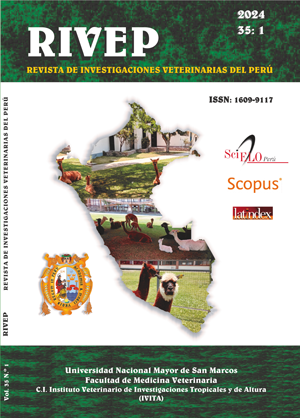Effect of delayed addition of fetal calf serum to the culture medium on in vitro embryo production from creole heifers raised in a high altitude in Ecuador
DOI:
https://doi.org/10.15381/rivep.v35i1.25307Keywords:
Ecuadorian creole heifers, OPU, fetal calf serum, cryotoleranceAbstract
This experiment aimed to assess the effect of fetal calf serum (FCS) added to culture medium on day 5 to 7 after in vitro fertilization on production and subsequent cryotolerance of blastocysts from Ecuadorian Creole heifers. Immature cumulus-oocyte complexes (COCs) were collected by ovum pick-up (OPU) from 10 Creole heifers and from ovaries collected at abattoir in eight collection sessions. COCs were subjected to in vitro maturation (IVM), fertilization (IVF), and culture (IVC). On day 1 after IVF, presumptive embryos from each oocyte source (OPU [O] and Abattoir [A]) were allocated randomly in two groups according to whether 2.5% (v/v) FCS was added to culture medium on day 5 after IVF: 1) O-FCS+, 2) O-FCS-, 3) A-FCS+, and 4) A-FCS-. On day 7 after IVF, high quality embryos were vitrified. Cryotolerance of vitrified-warmed embryos was assessed according to blastocele re-expansion at 2 h and subsequent re-expansion and hatching at 24 and 48 h of re-incubation. Blastocysts rate on day 7 did not differ between oocyte source and FCS group. After vitrification/warming process, addition of FCS affected the re-expansion rate only at 2 h, irrespective of the oocyte source (p<0.05). Likewise, blastocysts hatching rate at 48 h of incubation was drastically affected only in OPU-derived oocyte (p<0.01). Supplementation of FCS on day 5 after IVF did not improve blastocyst production and adversely affected the cryotolerance of in vitro bovine embryos derived from creole heifers raised on Ecuadorian Andean highlands.
Downloads
Downloads
Published
Issue
Section
License
Copyright (c) 2024 Maria S. Méndez, Daniel E. Argudo, Manuel E. Soria, Luis R. Galarza, Diego A. Galarza, Ricardo H. Alberio, Fernando P. Perea

This work is licensed under a Creative Commons Attribution 4.0 International License.
AUTHORS RETAIN THEIR RIGHTS:
a. Authors retain their trade mark rights and patent, and also on any process or procedure described in the article.
b. Authors retain their right to share, copy, distribute, perform and publicly communicate their article (eg, to place their article in an institutional repository or publish it in a book), with an acknowledgment of its initial publication in the Revista de Investigaciones Veterinarias del Perú (RIVEP).
c. Authors retain theirs right to make a subsequent publication of their work, to use the article or any part thereof (eg a compilation of his papers, lecture notes, thesis, or a book), always indicating the source of publication (the originator of the work, journal, volume, number and date).










